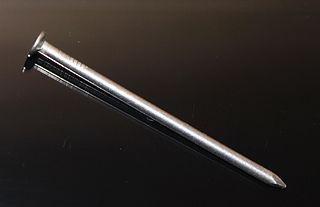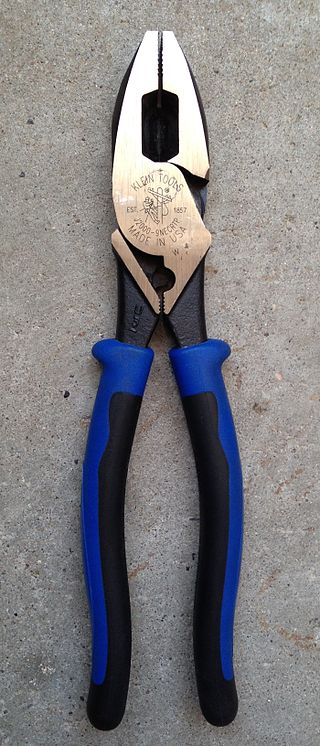
A hammer is a tool, most often a hand tool, consisting of a weighted "head" fixed to a long handle that is swung to deliver an impact to a small area of an object. This can be, for example, to drive nails into wood, to shape metal, or to crush rock. Hammers are used for a wide range of driving, shaping, breaking and non-destructive striking applications. Traditional disciplines include carpentry, blacksmithing, warfare, and percussive musicianship.

In woodworking and construction, a nail is a small object made of metal which is used as a fastener, as a peg to hang something, or sometimes as a decoration. Generally, nails have a sharp point on one end and a flattened head on the other, but headless nails are available. Nails are made in a great variety of forms for specialized purposes. The most common is a wire nail. Other types of nails include pins, tacks, brads, spikes, and cleats.

A claw is a curved, pointed appendage found at the end of a toe or finger in most amniotes. Some invertebrates such as beetles and spiders have somewhat similar fine, hooked structures at the end of the leg or tarsus for gripping a surface as they walk. The pincers of crabs, lobsters and scorpions, more formally known as their chelae, are sometimes called claws.

A chisel is a tool with a characteristically shaped cutting edge of blade on its end, for carving or cutting a hard material such as wood, stone, or metal by hand, struck with a mallet, or mechanical power. The handle and blade of some types of chisel are made of metal or of wood with a sharp edge in it.

Drill bits are cutting tools used in a drill to remove material to create holes, almost always of circular cross-section. Drill bits come in many sizes and shapes and can create different kinds of holes in many different materials. In order to create holes drill bits are usually attached to a drill, which powers them to cut through the workpiece, typically by rotation. The drill will grasp the upper end of a bit called the shank in the chuck.

A rivet is a permanent mechanical fastener. Before being installed, a rivet consists of a smooth cylindrical shaft with a head on one end. The end opposite the head is called the tail. On installation, the rivet is placed in a punched or drilled hole, and the tail is upset or bucked, so that it expands to about 1.5 times the original shaft diameter, holding the rivet in place. In other words, the pounding or pulling creates a new "head" on the tail end by smashing the "tail" material flatter, resulting in a rivet that is roughly a dumbbell shape. To distinguish between the two ends of the rivet, the original head is called the factory head and the deformed end is called the shop head or buck-tail.

A Halligan bar is a forcible entry tool used by firefighters.
Cat's paw or Catspaw may refer to:

A bottle opener is a device that enables the removal of metal bottle caps from glass bottles. More generally, it might be thought to include corkscrews used to remove cork or plastic stoppers from wine bottles.

A mandrel, mandril, or arbor is a gently tapered cylinder against which material can be forged or shaped, or a flanged or tapered or threaded bar that grips a workpiece to be machined in a lathe. A flanged mandrel is a parallel bar of a specific diameter with an integral flange towards one end, and threaded at the opposite end. Work is gripped between the flange and a nut on the thread. A tapered mandrel has a taper of approximately 0.005 inches per foot and is designed to hold work by being driven into an accurate hole on the work, gripping the work by friction. A threaded mandrel may have a male or female thread, and work which has an identical thread is screwed onto the mandrel.

A framing hammer is a form of claw hammer used for heavy wood construction, particularly house framing and concrete formwork. It is a heavy duty rip hammer with a straight claw and a wood, metal, or fiberglass handle. Head weights vary from 20 to 32 ounces for steel, and 12 to 16 ounces for titanium. Heavy heads, longer handles and milled faces allow for driving large nails quickly into dimensional lumber. Other features include a sharp checkerboard "milled" face for gripping nails, and, since the 1980s, an unusually large and short face for increasing driving area without increasing weight.

A claw hammer is a hammer primarily used in carpentry for driving nails into or pulling them from wood. Historically, a claw hammer has been associated with woodworking, but is also used in general applications. It is not suitable for heavy hammering on metal surfaces, as the steel of its head is somewhat brittle; the ball-peen hammer is more suitable for such metalwork.
A crowbar, also called a wrecking bar, pry bar or prybar, pinch-bar, or occasionally a prise bar or prisebar, colloquially, in Britain and Australia sometimes called a jemmy or jimmy, gooseneck, or pig foot, is a lever consisting of a metal bar with a single curved end and flattened points, used to force two objects apart or gain mechanical advantage in lifting; often the curved end has a notch for removing nails.

Japanese carpentry was developed more than a millennium ago through Chinese architectural influences from the 12th century. It is a form of ancient Chinese wooden architecture and woodworking joints that involves building wooden furniture without the use of nails, screws, glue, or electric tools.

Lineman's pliers, Kleins, linesman pliers, side cutting linesman pliers and combination pliers are a type of pliers used by linemen, electricians, and other tradesmen primarily for gripping, twisting, bending and cutting wire, cable and small metalwork components. They owe their effectiveness to their plier design, which multiplies force through leverage.

A slater, or slate mason, is a tradesperson who covers buildings with slate.

A punch is a tool used to indent or create a hole through a hard surface. They usually consist of a hard metal rod with a narrow tip at one end and a broad flat "butt" at the other. When used, the narrower end is pointed against a target surface and the broad end is then struck with a hammer or mallet, causing the blunt force of the blow to be transmitted down the rod body and focused more sharply onto a small area. Typically, woodworkers use a ball-peen hammer to strike a punch.

An axe is an implement that has been used for millennia to shape, split and cut wood, to harvest timber, as a weapon, and as a ceremonial or heraldic symbol. The axe has many forms and specialised uses but generally consists of an axe head with a handle, or helve.

A nailset or nail punch is a hand tool used for driving the exposed head of a nail or pin below the surface of a piece of wood, such as when installing decorative moulding or face-fastening wood flooring.

The Warrington hammer is a common woodworking tool that falls under the cross-peen category of hammers. The chisel-like cross-peen side of the hammer is used to set small nails and pins while the smaller, rounded face is used to finish driving in the aforementioned nail. The cross-peen side of the tool is also used for refining work, such as furniture and cabinet making. While the standard claw hammer would be more used for tasks that involve greater use of force, the Warrington hammer is preferred for projects that require precision, hence its prevalence in the art of woodworking. The most common length of a standard Warrington hammer is around twelve and a half inches in length with the hammer head weighing between ten to fourteen ounces.


















